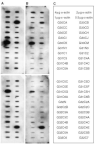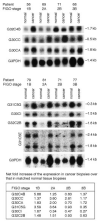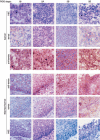Identification of molecular markers for the early detection of human squamous cell carcinoma of the uterine cervix
- PMID: 11870519
- PMCID: PMC2375172
- DOI: 10.1038/sj.bjc.6600038
Identification of molecular markers for the early detection of human squamous cell carcinoma of the uterine cervix
Abstract
To identify novel cellular genes that could potentially act as predictive molecular markers for human cervical cancer, we employed RT--PCR differential display, reverse Northern and Northern blot analysis to compare the gene expression profiles between squamous cell carcinoma biopsies and adjacent histo-pathological normal epithelium tissues. Twenty-eight cDNA clones were isolated that were demonstrated to be consistently over-expressed in squamous cell cervical cancer biopsies of FIGO stages 1B to 3B. Most importantly, it was observed that, in addition to their over-expression in cancer lesions, some of these genes are upregulated in the presumably histo-pathological normal adjacent tissues. Of particular interest is clone G30CC that has been identified to be the gene that encodes S12 ribosomal protein. When employed for RNA--RNA in situ hybridization experiments, expression of G30CC could be detected in the immature basal epithelial cells of histo-pathological normal tissues collected from cervical cancer patients of early FIGO stages. In comparison, the expression of G30CC was not detected in cervical tissues collected from patients admitted for surgery of non-malignant conditions. These results allow the distinct possibility of employing the ribosomal protein S12 gene as an early molecular diagnostic identifier for the screening of human cervical cancer and a potential target employed for cancer gene therapy trials.
Copyright 2002 The Cancer Research Campaign
Figures





References
-
- BassetPBellocqJPWolfCStollIHutinPLimacherJMPodhajcerOLChenardMPRioMCChambonP1990A novel metalloproteinase gene specifically expressed in stromal cells of breast carcinomas Nature 348699704 - PubMed
-
- BoschFXManosMMMunozNShermanMJansenAMPetoJSchiffmanMHMorenoVKurmanRShahKV1995Prevalence of human papillomavirus in cervical cancer: a worldwide perspective J Natl Cancer Inst 87796802 - PubMed
-
- BurkeTWHoskinsWJHellerPBShenMCWeiserEBParkRC1987Clinical patterns of tumor recurrence after radical hysterectomy in stage IB cervical carcinoma Obstet Gynecol 69382385 - PubMed
-
- ChanseobSZhangWChangHRLeeJH1998Profiling of differentially expressed genes in human primary cervical cancer by complementary DNA expression array Clin Cancer Res 430453050 - PubMed
MeSH terms
Substances
LinkOut - more resources
Full Text Sources
Other Literature Sources
Medical
Molecular Biology Databases

